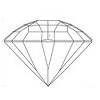16.27: Clinohumite
- Page ID
- 4363
\( \newcommand{\vecs}[1]{\overset { \scriptstyle \rightharpoonup} {\mathbf{#1}} } \)
\( \newcommand{\vecd}[1]{\overset{-\!-\!\rightharpoonup}{\vphantom{a}\smash {#1}}} \)
\( \newcommand{\dsum}{\displaystyle\sum\limits} \)
\( \newcommand{\dint}{\displaystyle\int\limits} \)
\( \newcommand{\dlim}{\displaystyle\lim\limits} \)
\( \newcommand{\id}{\mathrm{id}}\) \( \newcommand{\Span}{\mathrm{span}}\)
( \newcommand{\kernel}{\mathrm{null}\,}\) \( \newcommand{\range}{\mathrm{range}\,}\)
\( \newcommand{\RealPart}{\mathrm{Re}}\) \( \newcommand{\ImaginaryPart}{\mathrm{Im}}\)
\( \newcommand{\Argument}{\mathrm{Arg}}\) \( \newcommand{\norm}[1]{\| #1 \|}\)
\( \newcommand{\inner}[2]{\langle #1, #2 \rangle}\)
\( \newcommand{\Span}{\mathrm{span}}\)
\( \newcommand{\id}{\mathrm{id}}\)
\( \newcommand{\Span}{\mathrm{span}}\)
\( \newcommand{\kernel}{\mathrm{null}\,}\)
\( \newcommand{\range}{\mathrm{range}\,}\)
\( \newcommand{\RealPart}{\mathrm{Re}}\)
\( \newcommand{\ImaginaryPart}{\mathrm{Im}}\)
\( \newcommand{\Argument}{\mathrm{Arg}}\)
\( \newcommand{\norm}[1]{\| #1 \|}\)
\( \newcommand{\inner}[2]{\langle #1, #2 \rangle}\)
\( \newcommand{\Span}{\mathrm{span}}\) \( \newcommand{\AA}{\unicode[.8,0]{x212B}}\)
\( \newcommand{\vectorA}[1]{\vec{#1}} % arrow\)
\( \newcommand{\vectorAt}[1]{\vec{\text{#1}}} % arrow\)
\( \newcommand{\vectorB}[1]{\overset { \scriptstyle \rightharpoonup} {\mathbf{#1}} } \)
\( \newcommand{\vectorC}[1]{\textbf{#1}} \)
\( \newcommand{\vectorD}[1]{\overrightarrow{#1}} \)
\( \newcommand{\vectorDt}[1]{\overrightarrow{\text{#1}}} \)
\( \newcommand{\vectE}[1]{\overset{-\!-\!\rightharpoonup}{\vphantom{a}\smash{\mathbf {#1}}}} \)
\( \newcommand{\vecs}[1]{\overset { \scriptstyle \rightharpoonup} {\mathbf{#1}} } \)
\( \newcommand{\vecd}[1]{\overset{-\!-\!\rightharpoonup}{\vphantom{a}\smash {#1}}} \)
\(\newcommand{\avec}{\mathbf a}\) \(\newcommand{\bvec}{\mathbf b}\) \(\newcommand{\cvec}{\mathbf c}\) \(\newcommand{\dvec}{\mathbf d}\) \(\newcommand{\dtil}{\widetilde{\mathbf d}}\) \(\newcommand{\evec}{\mathbf e}\) \(\newcommand{\fvec}{\mathbf f}\) \(\newcommand{\nvec}{\mathbf n}\) \(\newcommand{\pvec}{\mathbf p}\) \(\newcommand{\qvec}{\mathbf q}\) \(\newcommand{\svec}{\mathbf s}\) \(\newcommand{\tvec}{\mathbf t}\) \(\newcommand{\uvec}{\mathbf u}\) \(\newcommand{\vvec}{\mathbf v}\) \(\newcommand{\wvec}{\mathbf w}\) \(\newcommand{\xvec}{\mathbf x}\) \(\newcommand{\yvec}{\mathbf y}\) \(\newcommand{\zvec}{\mathbf z}\) \(\newcommand{\rvec}{\mathbf r}\) \(\newcommand{\mvec}{\mathbf m}\) \(\newcommand{\zerovec}{\mathbf 0}\) \(\newcommand{\onevec}{\mathbf 1}\) \(\newcommand{\real}{\mathbb R}\) \(\newcommand{\twovec}[2]{\left[\begin{array}{r}#1 \\ #2 \end{array}\right]}\) \(\newcommand{\ctwovec}[2]{\left[\begin{array}{c}#1 \\ #2 \end{array}\right]}\) \(\newcommand{\threevec}[3]{\left[\begin{array}{r}#1 \\ #2 \\ #3 \end{array}\right]}\) \(\newcommand{\cthreevec}[3]{\left[\begin{array}{c}#1 \\ #2 \\ #3 \end{array}\right]}\) \(\newcommand{\fourvec}[4]{\left[\begin{array}{r}#1 \\ #2 \\ #3 \\ #4 \end{array}\right]}\) \(\newcommand{\cfourvec}[4]{\left[\begin{array}{c}#1 \\ #2 \\ #3 \\ #4 \end{array}\right]}\) \(\newcommand{\fivevec}[5]{\left[\begin{array}{r}#1 \\ #2 \\ #3 \\ #4 \\ #5 \\ \end{array}\right]}\) \(\newcommand{\cfivevec}[5]{\left[\begin{array}{c}#1 \\ #2 \\ #3 \\ #4 \\ #5 \\ \end{array}\right]}\) \(\newcommand{\mattwo}[4]{\left[\begin{array}{rr}#1 \amp #2 \\ #3 \amp #4 \\ \end{array}\right]}\) \(\newcommand{\laspan}[1]{\text{Span}\{#1\}}\) \(\newcommand{\bcal}{\cal B}\) \(\newcommand{\ccal}{\cal C}\) \(\newcommand{\scal}{\cal S}\) \(\newcommand{\wcal}{\cal W}\) \(\newcommand{\ecal}{\cal E}\) \(\newcommand{\coords}[2]{\left\{#1\right\}_{#2}}\) \(\newcommand{\gray}[1]{\color{gray}{#1}}\) \(\newcommand{\lgray}[1]{\color{lightgray}{#1}}\) \(\newcommand{\rank}{\operatorname{rank}}\) \(\newcommand{\row}{\text{Row}}\) \(\newcommand{\col}{\text{Col}}\) \(\renewcommand{\row}{\text{Row}}\) \(\newcommand{\nul}{\text{Nul}}\) \(\newcommand{\var}{\text{Var}}\) \(\newcommand{\corr}{\text{corr}}\) \(\newcommand{\len}[1]{\left|#1\right|}\) \(\newcommand{\bbar}{\overline{\bvec}}\) \(\newcommand{\bhat}{\widehat{\bvec}}\) \(\newcommand{\bperp}{\bvec^\perp}\) \(\newcommand{\xhat}{\widehat{\xvec}}\) \(\newcommand{\vhat}{\widehat{\vvec}}\) \(\newcommand{\uhat}{\widehat{\uvec}}\) \(\newcommand{\what}{\widehat{\wvec}}\) \(\newcommand{\Sighat}{\widehat{\Sigma}}\) \(\newcommand{\lt}{<}\) \(\newcommand{\gt}{>}\) \(\newcommand{\amp}{&}\) \(\definecolor{fillinmathshade}{gray}{0.9}\)| Clinohumite | |
|---|---|
| Chemical composition | Magnesium silicate |
| Hardness | 6 |
| Optic nature | Biaxial + |
| Refractive index | 1.628 - 1.674 |
| Birefringence | 0.024 - 0.041 |
| Specific gravity | ~ 3.21 |
| Lustre | Vitreous |
| Pleochroism | Strongly trichroic |
| Fluorescence |
SWUV: strong orange yellow |

Figure \(\PageIndex{1}\): A 9.45 ct brownish orange clinohumite tested at the Gem Testing Laboratory, Jaipur.
Clinohumite is a member of the humite group. As a gemstone it is rare, but some cut stones are reported. The given below details are (largely) abstracted from Journal of Gemmology, 2007, 30, 5/6, 303-306 "A remarkably large clinohumite".
Crystallography
Monoclinic
Diagnostics
Color
Bright yellow-orange color resembling some hessonite and spessartine garnets.
Cause of color: Mn
Diaphaneity
Transparent
Refractometer
Clinohumite has a biaxial optic character with a positive optic sign.
The refractive index range of clinohumite: nα = 1.628 - 1.638, nβ = 1.641 - 1.654, nγ = 1.662 - 1.674.
The maximum birefringence ranges from 0.024 to 0.041.
For a specific stone tested (9.45 ct. brownish orange clinohumite tested at the Gem Testing Laboratory, Jaipur): R.I.: 1.646-1.670, birefringence: 0.024.
Pleochroism
Strong trichroism: yellow, orange and brownish yellow.
Specific gravity
S.G.: ~ 3.21
Spectrum

Figure \(\PageIndex{2}\): Diffraction spectrum
Brownish-orange clinohumite.
General cut-off till 430nm (from 400nm).
Luminescence
SWUV: strong orange-yellow;
LWUV: generally inert
Magnification
Inclusions: Strong color and growth zoning, flat parallel reflective planes, fluid-like inclusions similar to trichites in tourmaline. Such liquid inclusions along with doubling appear very much like tourmaline; tube like inclusions; sometimes swirly zones.
Occurrence
Geographical occurrence: Gem quality Clinohumite is known to occur in two important localities - The Pamir mountains (at Kukh-i-lal, Sumdzin and Changin); in Tajikistan in association with spinel and in the Taymyr region (Basin of Kotui river) in Siberia; Also in Mahenge, Tanzania.
References
- G.Choudhary and Chaman Golecha, A remarkably large Clinohumite, Journal of Gemmology, 2007, 30, 5/6, pp 303-306
- Henn, U., Hyrsl, J., and Milisenda, C.C., Gem Quality clinohumite from Tajikistan and the Taymyr region, Northern Siberia. Journal of Gemmology, 27(6), 335-9
- Hyrsl, J., 2001. Gem News International. Spinel with clinohumite from Mahenge, Tanzania, Gems and Gemology, 37(2), 144-5
- Laurs, B.M., and Quinn, E.P., 2004. Gem News International. Clinohumite from Mahenge, Tanzania. Gems and Gemology, 40(4), 337-8
- Gems Their Sources, Descriptions and Identification 4th Edition (1990) - Robert Webster (6th ed.)
- Colour Encyclopedia - J.E. Arem ISBN 0412989115
- Introduction to Optical Mineralogy 3rd edition (2003), Prof. W.D. Nesse


